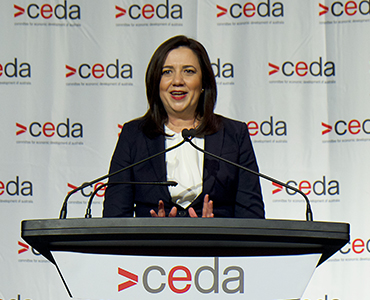“Just as we need a road map for our health recovery, we need a strong plan for our economic recovery,” Queensland Premier the Hon. Annastacia Palaszczuk told a CEDA audience at the State of the State in Brisbane.
 The Premier said in outlining the economic recovery plan that “we can’t just build the economy back to the way it was it was before, we have to build it back better.”
The Premier said in outlining the economic recovery plan that “we can’t just build the economy back to the way it was it was before, we have to build it back better.”
“Queensland’s economic recovery plan has been developed to respond to a set of conditions never seen before in our lifetime,” she said.
The Premier laid out six priorities for economic recovery.
“One: we must safeguard Queenslanders health so that we remain pandemic ready and build community resilience but crucially by doing that we can keep the economy open,” she said.
“Two: we must back small business by buying local, by increasing skills and capability and, by making it easier to do business here in Queensland.
“Three: we are committed to ‘making it’ for Queensland, attracting manufacturers to our state and powering regional development.
“Four: my government is committed to building Queensland’s infrastructure.”
This includes a $51.8 billion infrastructure plan with $13.9 billion over the next year, supporting 44,000 jobs she said.
“Five: we are committed to growing our regions with regional partnerships and by delivering critical new energy and water projects and businesses will create exports,” she said.
“And six: we are investing in skills by encouraging apprenticeships and creating pathways for young Queenslanders.
“It's a plan that will support 55,000 jobs over the next year through direct infrastructure investment and by unlocking private investment, and it builds on our immediate response that has supported businesses to keep 334,000 Queenslanders in jobs.”
During the address, the Premier also announced that the state government is delivering $145 million to unlock three Queensland renewable energy corridors in North Queensland, Central Queensland and Southwest Queensland.
“We will map out areas within Queensland for investment in renewables solar and wind by supporting the delivery of transmission infrastructure,” she said.
In North Queensland this includes a focus on “new economy minerals” such as CopperString 2.0, process manufacturing and hydrogen.
“Achieving internationally competitive energy prices in the northwest minerals province would mean 3500 more jobs in North Queensland, delivering the minerals needed globally for batteries renewables and electronics.
“In Central Queensland there's potential for projects in the Fitzroy and wide bay renewable energy zones. These would make our aluminium and smelting industries more competitive with strong potential as well for hydrogen development.
“In the Southwest the Darling Downs renewable energy zone will meet demand from agricultural production and has the potential to help supply New South Wales.
“These renewable energy zones will support Powerlink to invest further funding and CleanCo to increase their publicly owned renewable generation capacity to deliver energy security.”
Ms Palaszczuk said that these zones would also secure more manufacturing jobs.
“COVID has taught us that our economic recovery must be driven by Queensland for Queenslanders,” she said.
“In an increasingly uncertain global environment where supply chains are being broken, we must ensure that as a nation we have the capacity to make products locally. That means rethinking (what) businesses and governments go overseas to manufacture and what we make here.”
The Premier signalled her government’s intent to keep the state’s borders closed.
“We closed the borders to stop the import of the disease.
“There are now more active cases in aged care in Victoria than Queensland has had during the entire pandemic.
“I will continue to do everything I can to protect Queenslanders against this disease and against criticism and we will continue to be guided by the best health advice.
“It’s clear to me the Queensland economy can only open because our borders our closed.
“Treasury estimates lifting stage three restrictions is supporting $520 million worth of economic output each month and an additional 50,000 jobs.
“Since the easing of restrictions, there are 66,800 more jobs in Queensland from May to July.
“This has led to the participation rate recovering, which means more Queenslanders are trying to get back into the workforce, and the latest Seek job ads data for August shows Queensland job ads ahead of New South Wales.”
However the Premier highlighted there was a long road ahead.
“The global shutdown of the tourism and international study industries have hit us really hard,” she said.
“We still have 138,000 fewer jobs than prior to the pandemic.”